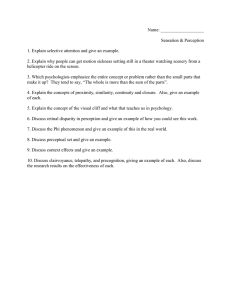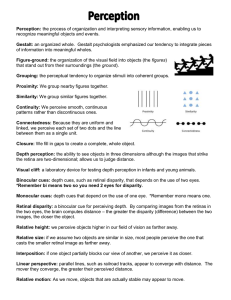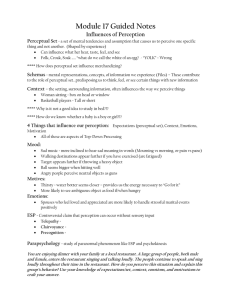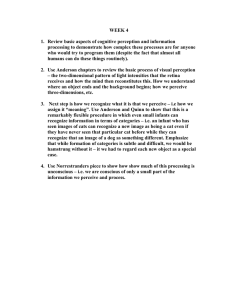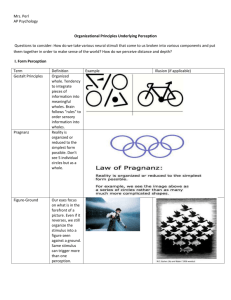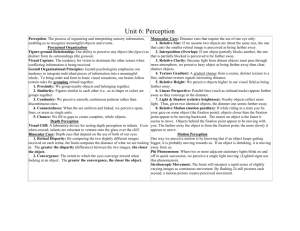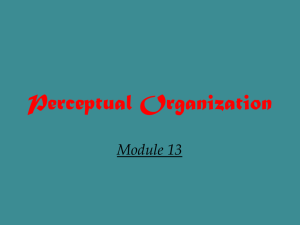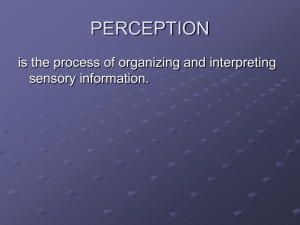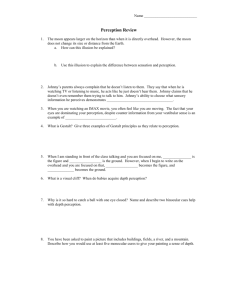Perception Examples Power Point
advertisement
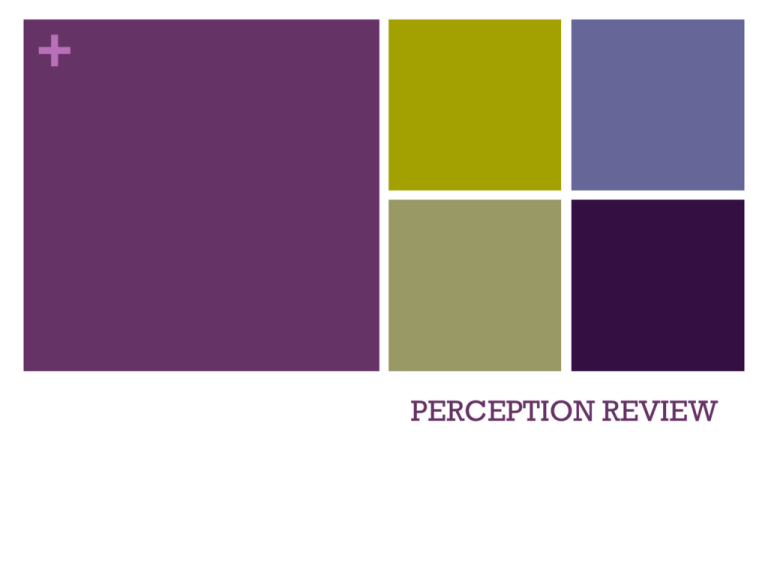
+ PERCEPTION REVIEW + PERCEPTION REVIEW + + Proximity: We group nearby figures together. + + Schema: Organized bodies of information that are stored in memory which can bias the way new information is interpreted, stored, and recalled. + + Visual cliff: a laboratory device for testing depth perception in infants and young animals. + + Continuity: We perceive smooth, continuous patterns rather than discontinuous ones. + + Figure-ground: the organization of the visual field into objects (the figures) that stand out from their surroundings (the ground). + + Relative size: if we assume two objects are similar in size, most people perceive the one that casts the smaller retinal image as farther away. + + + Closure: We fill in gaps to create a complete, whole object. + + Grouping: the perceptual tendency to organize stimuli into coherent groups. + + Depth perception: the ability to see objects in three dimensions although the images that strike the retina are two-dimensional; allows us to judge distance. + + Relative height: we perceive objects higher in our field of vision as farther away. + + Connectedness: Because they are uniform and linked, we perceive each set of two dots and the line between them as a single unit. + + + Retinal disparity: a binocular cue for perceiving depth. By comparing images from the retinas in the two eyes, the brain computes distance – the greater the disparity (difference) between the two images, the closer the object. + + Interposition: if one object partially blocks our view of another, we perceive it as closer. + + Linear perspective: parallel lines, such as railroad tracks, appear to converge with distance. The mover they converge, the greater their perceived distance. + + Perceptual set: a mental predisposition to perceive one thing and not another. + + Relative motion: As we move, objects that are actually stable may appear to move. + + Similarity: We group similar figures together. + + Light and shadow: nearby objects reflect more light to our eyes. Thus, given two identical objects, the dimmer one seems farther away. Shading, too, produces a sense of depth consistent with our assumption that light comes from above. + + + Color constancy: perceiving familiar objects as having consistent color, even if changing illumination alters the wavelengths reflected by the object. + + Gestalt: an organized whole. Gestalt psychologists emphasized our tendency to integrate pieces of information into meaningful wholes. + + Phi Phenomenon: an illusion of movement created when two or more adjacent lights blink on and off in quick succession, like Christmas lights. + + Perceptual constancy: perceiving objects as unchanging (having consistent shapes, size, lightness, and color) even as illumination and retinal images change. + + + + Context effects: describes the influence of environmental factors on one's perception of a stimulus. + + + Telepathy: mind-to-mind communication, one person sending thoughts to another or perceiving another’s thoughts. Clairvoyance: perceiving remote events, such as sensing that a friend’s house is on fire. + + Extrasensory Perception (ESP): the controversial claim that perception can occur apart from sensory input; includes telepathy, clairvoyance, and precognition. + + Parapsychology: the study of paranormal phenomena, including ESP and psychokinesis.
